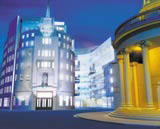Behind the scenes
The BBC is pushing boundaries in office interior design. Hannah Booth takes a walk backstage with head of interiors John Dee to find out how it’s doing it

If his supporters are to be believed, BBC director-general Greg Dyke has bought a culture of openness, creative risk-taking and ‘Just Do It’ mentality to the corporation. But not to its buildings. The BBC’s offices – environments in which ideas are expected to spark – are at best tatty. At worst, they’re hostile and unstimulating, and John Dee’s trying to change that.
As BBC head of interiors, Dee is overseeing a major redevelopment of the corporation’s sites nationwide. He’s also embarking on one of the most ambitious office design projects I’ve ever seen.
In step with Dyke’s cultural revolution, Dee is empowering all staff to design their own spaces. Come the autumn, they will be handed £250 each to use as they want. Bean bags, fish tanks and potted palms are welcome. Model railways, basketball hoops and rabbit hutches may be less so.
If that sounds like professional suicide, the reality could have been riskier still. Dyke, breathless with enthusiasm for the scheme, wanted to hand every aspect of office design over to staff, but Dee convinced him the ‘high value’ furniture should fall under BBC Property’s remit, leaving around 12 per cent of the budget to staff.
Will it work? ‘We don’t know,’ says Dee, who is still finalising details. ‘But it should encourage staff to talk to each other.’
This is just one of the BBC’s current design schemes. It is about to appoint an architect to create its Music Centre at White City, which, come 2006, will house the BBC Symphony Orchestra, Symphony Chorus, Concert Orchestra and Singers. Foreign Office Architects, Future Systems, Zaha Hadid, MVRDV and Ushida Findlay Architects were shortlisted with one, undisclosed group now out of the running.
According to John Smith, BBC director of finance, property and business affairs, who is chairing the jury, the BBC wants ‘a dramatic, iconic building that makes a statement and creates a buzz inside and outside the BBC. We are not afraid to champion a potentially controversial design; indeed, we relish the opportunity [to do so]’.
If the BBC attracts the best broadcasters, writers, actors, artists and technicians, Smith argues, why can’t it add architects to that list?
Having Smith behind BBC Property’s plans is vital, as he controls the purse-strings, says Dee. ‘Property used to fall under Resources, but now sits centrally. [Smith] is our champion,’ he says. So too is Dyke. According to Dee, he took time recently to attend a property meeting in Swansea. ‘As [Dyke] sees it, our buildings are part of our brand,’ Dee says.
But it’s not just headlinegrabbing flagship buildings that Dee is addressing. Every provincial radio station is a BBC ambassador, he believes, and they should be seen not just heard.
BBC Property was set up three years ago, headed by director Ian Robertson, to look at the corporation’s buildings and use of office space. At present, the latter is inefficient, Dee says. ‘Over half our staff are out of their offices at any time,’ he says.
Hot-desking isn’t the answer, he says. Instead, Dee is deliberately providing staff with less space than they believe they need to encourage a change in working culture.
‘When people work on their own, they don’t need to be in an office. People here come to work to meet colleagues and brainstorm ideas. And for that, they don’t need their own desks,’ he says.
The social philanthropist in Dee also drives his workplace design philosophy. ‘If the home became a recognised workplace, people would spend less time gridlocked in traffic and more time with their families,’ he says.
With meetings and face-to-face working assuming greater importance, interiors will need to reflect this. ‘We will need less space in the future and offices will become more domestic-influenced and “dressed-down”,’ he says.
With this in mind, Dee shows me concrete proof of the BBC’s new direction. High up in Television Centre, an Ideo-designed section of office, which opened six weeks ago, glistens white and spacious alongside neighbouring, un-refurbished spaces with stained carpets and dark dividing screens.
The space is exactly where the BBC should be heading, Dee says. It has white desks, bean bags and second-hand furniture, all chosen by staff. Hell, they even look happy.
Next up is the BBC’s ‘entertaining’ suite on the hallowed sixth floor. Amalgam, which redesigned the BBC’s newsroom, was appointed last month to remove its corporate-blue seats and sixth-form common room aura.
Elsewhere, Imagination is designing White City’s Central Office Building reception, and DEGW is designing the bulk of the latter’s interiors (DW 26 June).
It’s the public-facing architectural work, of course, that will get the most attention. The BBC’s best-loved building, the iconic Art Deco Broadcasting House, is being transformed by MacCormac Jamieson Prichard. And if the Music Centre lives up to its brief, the BBC no doubt hopes it could become the next Sydney Opera House. But to overlook the BBC’s interiors would fail the very people whose creative ideas make the corporation tick.
John Dee’s CV
1993 Joins BBC, first in Manchester. Moves to London in 1997
Early 1980s After working in various roles in theatre, concluding with five years as technical director of Scottish Opera, joins Yorkshire Television as design manager
-
Post a comment




